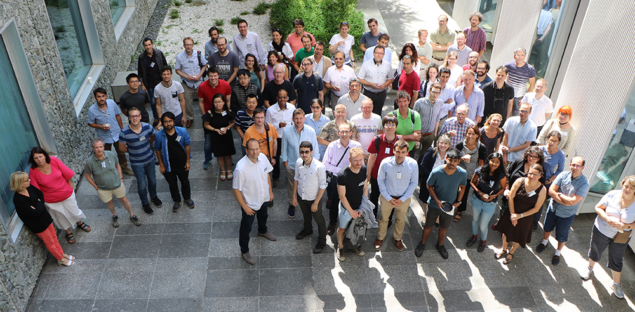
The 10th Higgs Hunting workshop took place in Orsay and Paris from 29–31 July, attracting 110 physicists for lively discussions about recent results in the Higgs sector. The ATLAS and CMS collaborations presented Run 2 analyses with up to 140 fb–1 of data collected at a centre-of-mass energy of 13 TeV. The statistical uncertainty on some Higgs properties, such as the production cross-section, has now been reduced by a factor three compared to Run 1. This puts some Higgs studies on the verge of being dominated by systematic uncertainties. By the end of the LHC’s programme, measurements of the Higgs couplings to the photon, W, Z, gluon, tau lepton and top and bottom quarks are all expected to be dominated by theoretical rather than statistical or experimental uncertainties.
Several searches for additional Higgs bosons were presented. The general recipe here is to postulate a new field in addition to the Standard Model (SM) Higgs doublet, which in the minimal case yields a lone physical Higgs universally associated with the particle discovered at the LHC with a mass of 125 GeV in 2012. Adding a hypothetical additional Higgs doublet, however, as in the two Higgs doublet model, would yield five physical states: CP-even neutral Higgs bosons h and H, the CP-odd pseudoscalar A, and two charged Higgs bosons H±; the model would also bequeath three additional free parameters. Other models discussed at Higgs Hunting 2019 include the minimal and next-to-minimal supersymmetric SMs and extra Higgs states with doubly charged Higgs bosons. Anna Kaczmarska from ATLAS and Suzanne Gascon-Shotkin from CMS described direct searches for such additional Higgs bosons decaying to SM particles or Higgs bosons. Loan Truong from ATLAS and Yuri Gershtein from CMS described studies of rare – and potentially beyond-SM – decays of the 125 GeV Higgs boson. No significant excesses were reported, but hope remains for Run 3, which will begin in 2021.
Nobel laureate Gerard ’t Hooft gave a historical talk on the role of the Higgs in the renormalisation of electroweak theory, recalling the debt his Utrecht group, where the work was done almost 50 years ago, owed to pioneers like Faddeev and Popov. Seven years after the particle’s discovery, we now know it to be spin-0 with mainly CP-even interactions with bosons, remarked Fabio Cerutti of Berkeley in the experimental summary. With precision on the Higgs mass now better than two parts per mille, all of the SM’s free parameters are known with high precision, he continued, and all but three of them are linked to Higgs-boson interactions.
Give me six hours to chop down a tree and I will spend the first four sharpening the axe.
Abraham Lincoln
Hunting season may now be over, Cerutti concluded, but the time to study Higgs anatomy and exploit the 95% of LHC data still to come is close at hand. Giulia Zanderighi’s theory summary had a similar message: Higgs studies are still in their infancy and the discovery of what seems to be a very SM-like Higgs at 125 GeV allows us to explore a new sector with a broad experimental programme that will extend over decades. She concluded with a quote from Abraham Lincoln: “Give me six hours to chop down a tree and I will spend the first four sharpening the axe.”
The next Higgs Hunting workshop will be held in Orsay and/or Paris from 7–9 September 2020.





